How to dry chillies – 3 easy ways
I’ve just learned how to dry chillies Italian-style.
If you stroll round the ancient hilltop towns of southern Italy in October, you will see strings of chillies drying everywhere.
We’re all growing more chillies now, and ‘Chilli Festivals’ are the fastest-growing horticultural event in the UK. But, like all homegrown fruit and vegetable, you do suddenly get alot of chillies at once.
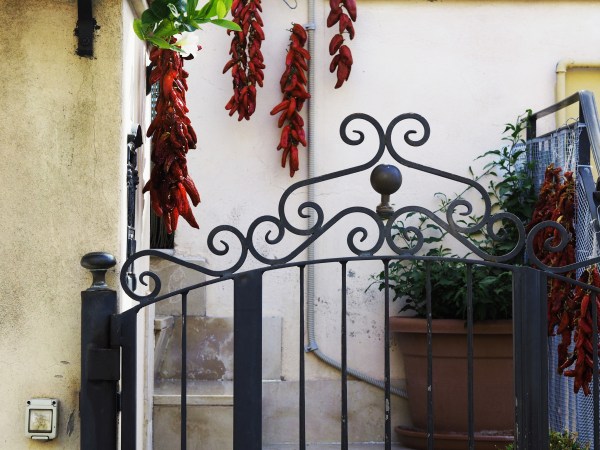
Many houses in this hilltop town have chillies hanging to dry from the the windows.
Preserving your homegrown fruit, vegetables and herbs is an art form in Italy. Nothing is wasted – and the southern part is poorer than the north. Preserving is frugality made beautiful.
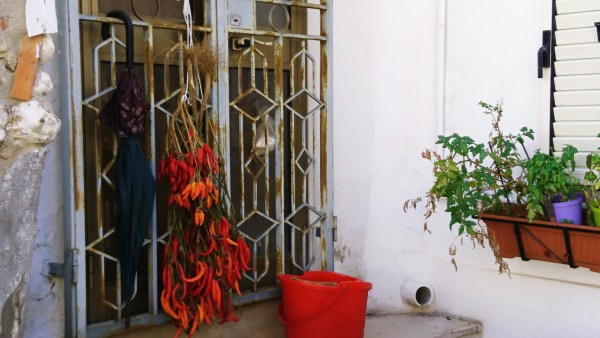
More chillies hanging out to dry. The owners of the house may have grown these in pots, or bought them in big branches from the local greengrocers.
My sister-and-brother-in-law, Penny and Peter, have just moved to a small hillside olive farm in Basilicata (the instep of Italy’s ‘boot’). Their three room cottage – or casa di campagna – is filled with bottles and jars of Penny’s home preserved and home-grown goodies.
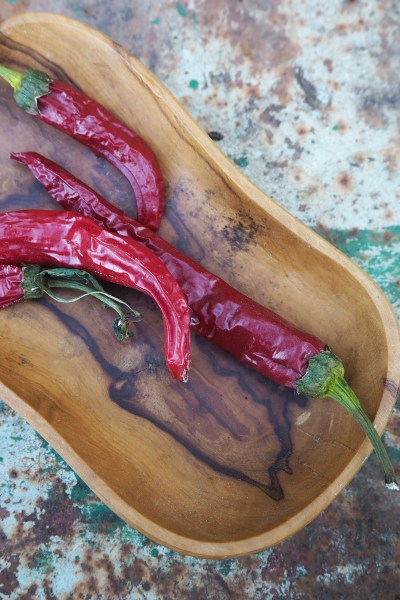
Penny’s home-dried chillies.
There are strings of dry chillies – or drying chillies – hanging both inside and outside the house.
Last year I froze my spare homegrown chillies. All I got was a soggy and tasteless mess (although chillies are supposed to freeze, so I must have done something wrong.) So I asked Penny to show me the Italian ways of drying chillies.
The super-easy way to dry chillies…
If you grow your own chillies, then the easiest way of drying them is to dig the whole plant up, shake the earth off and hang it upside down in a well-ventilated place.
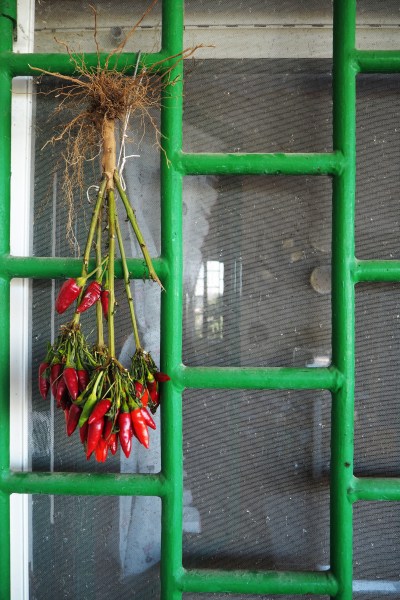
Penny and Peter’s casa di campagna has attractive green windows. Penny has used the bars to hang a chilli plant upside down to dry.
Penny’s Italian neighbours told her to dry chillies out of direct sunlight, but we saw several strings of chillies drying in quite sunny spots. So I think it’s a question of trial and error.
You might try a greenhouse, a kitchen window or even a warm airing cupboard.
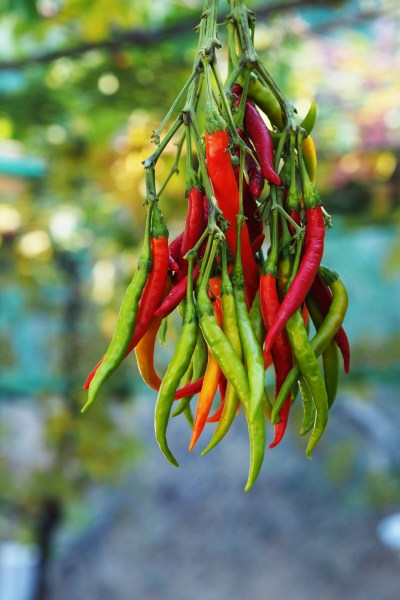
Hang your chillies in a well ventilated greenhouse, potting shed or at the kitchen window. The UK is more humid than southern Italy, so keep an eye out for rot or mould.
It’s really not much more complicated than that, although you do need to pick the leaves off. And snip off any chilli that is bruised or rotting. Penny advises you to turn the bunch every few days, giving it a gentle shake to shed any remaining leaves.
The temperature at Penny’s, incidentally, ranges from 12-25C/50-73F in October, getting quite cold at night. When we were there, it was roughly the same temperature as Kent (UK), although we were having a bit of a late heat wave!
How to create beautiful strings of dry chillies
A string of chillies is called a ristra. This method is good if you grow your own chillies or buy big bunches of chillies, still on the branch, from farmers’ markets. It’s also good for drying peppers.
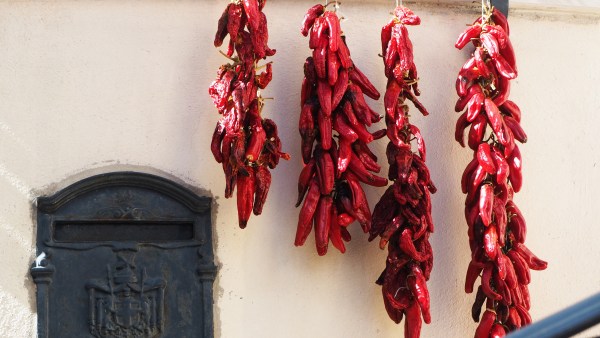
Strings of chillies hanging outside a house in town. Choose a spot with good air circulation.
Cut the chillies off the branch leaving a longish stem – around 3cm is good.
You need a strong, fine thread – raid the sewing basket, or use fine fishing thread. If using cotton thread, use a double thickness.
Tie a knot at the end, so the chillies can’t slip off. This needs to have a bow, so you can hang the chillies.
Then thread the needle through the cap of the chilli, where it joins the stalk. Don’t pierce it too far up the stalk or it will split.
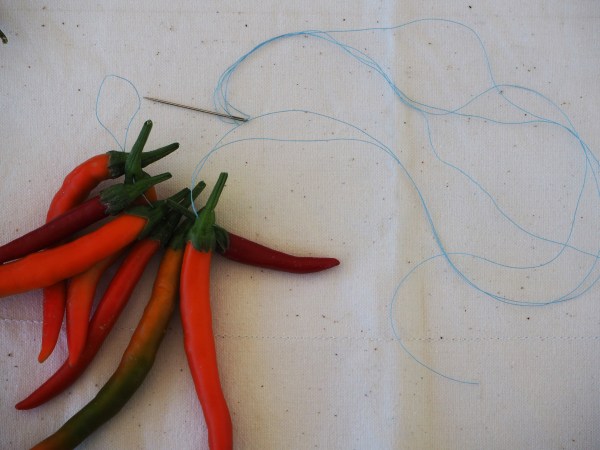
The thread goes through the ‘cap’ of the chillies.
Gently work the chilli down to the knot. Repeat. When you have threaded the whole string, spread the chillies out as much as possible, so that each chilli faces a different way to the one above.
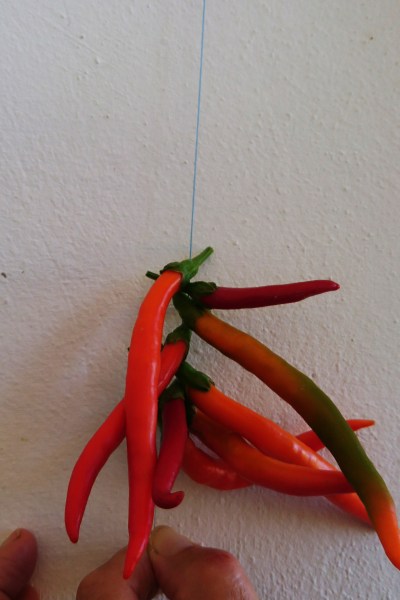
Make sure that each chilli faces in a different direction from the one above.
See how Penny does a ristra in this video here:
How long do the chillies take to dry?
How long is a piece of string threaded with chillies? Seriously, though, it’s a question of how warm and dry the weather is, and how much ventilation your chillies get. Some people suggest that chillies dry in the open air in three days, but I think that’s optimistic, especially in October.
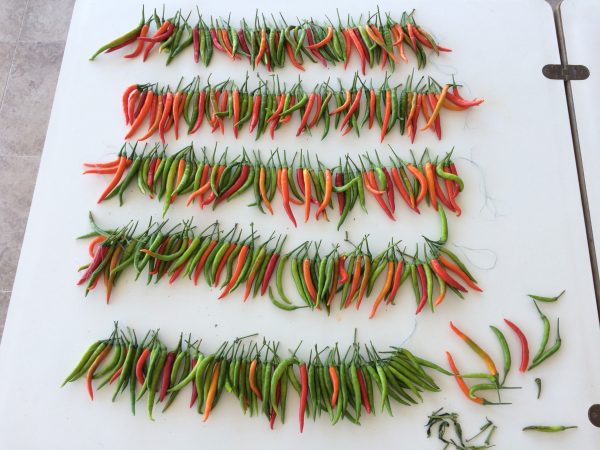
All the chillies strung up, ready to hang.
Check the string every few days, turning it upside down and hanging it from what was the bottom. Remove any rotting chillies. When the chillies start to rattle with a noise like scrunched-up tissue paper, they are ready. You can cut them up and put them in jars. Or leave them hanging in festive strings.
How to dry chillies in the oven
This is quicker but less beautiful.
Penny has dried some of her chillies flat in the sunlight, but I suspect that there isn’t enough Northern hemisphere sunshine to make this workable for many of us. We will need to turn on our ovens (very low – around 40C). The warming oven of an Aga is perfect, too.
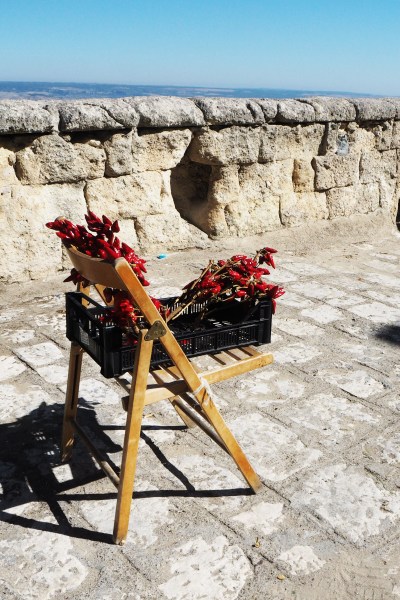
Chillies drying on a chair in the sun in a street in Puglia. We probably don’t have enough sunlight for this method in the UK – but if your chillies ripen early in August, you could try it. Otherwise it’s the oven! Or Penny’s Italian greengrocer dries her chillies on the top of the fridge, where there is some circulation of warm air.
Spread the chillies out on a piece of baking paper in a flat or roasting tin. Put them in the oven and check them every 30-45 minutes to make sure they don’t burn. This can take 3-6 hours, depending on your oven temperature and how big your chillies are.
In Puglia, people use chillies instead of pepper, adding a little chilli to most dishes.
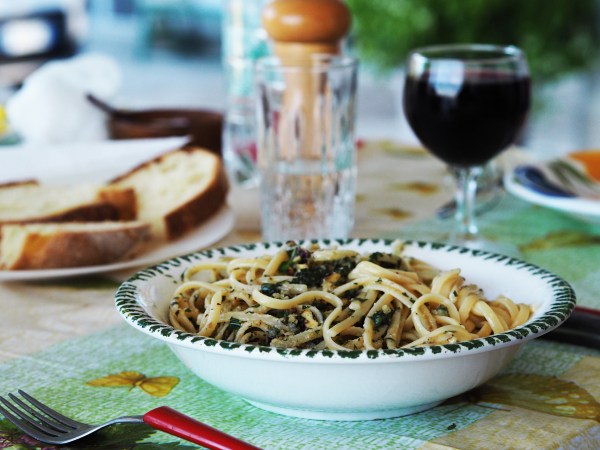
Penny’s pesto is made almost entirely from homegrown nuts and basil. She’s added a little chilli instead of pepper.
You can see the video about drying chillies on the Middlesized Garden YouTube channel – do pop over and see more videos on gardening ideas and inspiration.
Shop my favourite gardening books, tools and products
I’m often asked for recommendations so I’ve put together some useful lists on the Middlesized Garden Amazon store. Note that links to Amazon are affiliate which means I may get a small fee if you buy, but I only recommend things I use myself.
For example, there are some good veg growing books plus seed trays, seaweed fertilisers, plant labels and more in my Homegrown Veg Growers list.
Pin to remember how to dry chillies
And do join us on the Middlesized Garden blog every Sunday morning. See here for how to follow by email.

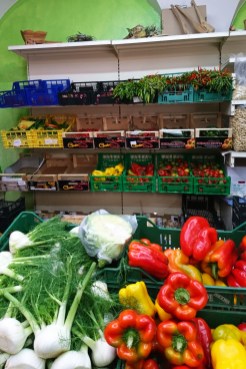

























I have read that chilli plants are perennials so I am going to attempt to keep my plant which is in the ground in the greenhouse going for the next couple of years. It has fruited well this first year so I have plenty to snip off and hang to dry!
Good idea, and good luck with it.
This is very helpful – thank you!
Looking forward to all ideas available
Regards
Newby Taylor
I’m so looking forward to doing this if my first attempt at growing chillies is successful. How do I store them after I’ve dried them? If I put them in a jar, do I need to add oil? Do they need to be kept in the fridge or can they be kept in a cupboard or on a kitchen shelf?
Dried chillies store very easily. Keep them in a jar or if you’ve hung them on a string, then you can leave them hanging in the open. I had three strings of chillies hanging in my kitchen for around a year and they looked great.
I grow my own chilies and prefer sun-drying them, but that doesn’t really work well in the winter where I live. I’ve been hanging them indoors near a heat source, but think I will give the oven a try this year.
I found a very low oven really effective – and somehow homegrown dried chillies seem to taste better than those in packets from the supermarket.
We always seem to have a glut of chillies in early autumn, and I usually dry them, on a string, above the dining room radiator. I’ve seen people recommend drying above a cooker in the kitchen but feel it can get too damp, with potatoes/pasta/rice boiling for dinner. I think they look quite cheery and festive, but my eldest daughter insists they look like entrails hung up for Halloween!
Dining room radiator is a great idea!